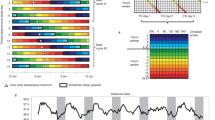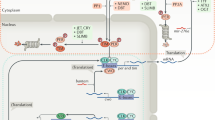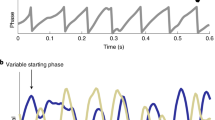Abstract
CIRCADIAN periodicity has been observed in many organisms. Motor activity, body temperature, and oxygen consumption are among the functions shown to possess a diurnal rhythm. Many of these rhythms are easily entrained to a natural or artificial cycle of light and darkness. In constant laboratory conditions of light and temperature, rhythms persist, but are slightly longer or slightly shorter than 24 h (ref. 1). The persistence of rhythms in constant conditions together with the evidence from translocation experiments2, are considered evidence that rhythms are endogenous. Many researchers, among them Pittendrigh3, Aschoff4, and Enright5, adhere to the endogenous rhythm hypothesis.
This is a preview of subscription content, access via your institution
Access options
Subscribe to this journal
Receive 51 print issues and online access
$199.00 per year
only $3.90 per issue
Buy this article
- Purchase on Springer Link
- Instant access to full article PDF
Prices may be subject to local taxes which are calculated during checkout
Similar content being viewed by others
References
Palmer, J. D., Comp. Biochem. Physiol., 12, 273–282 (1964).
Renner, M., Cold Spring Harb. Symp. quant. Biol., 25, 361–367 (1960).
Pittendrigh, C. S., Cold Spring Harb. Symp. quant. Biol., 25, 159–184 (1960).
Aschoff, J., A. Rev. Physiol., 25, 581–600 (1963).
Enright, T. J., J. theor. Biol., 8, 426–468 (1965).
Brown, F. A., Jr., Cold Spring Harb. Symp. quant. Biol., 25, 57–71 (1960).
Brown, F. A., Jr., in Circadian Clocks (edit. by Aschoff, J.), 231–261 (North-Holland, Amsterdam, 1965).
Brown, F. A., Jr., Barnwell, F. H., and Webb, M., Biol. Bull., 127, 221–231 (1964).
Wever, R., Naturwissenschaften, 55, 29–32 (1968).
Keeton, W. T., Larkin, T. S., and Windsor, D. M., Z. vergl. Physiol., 95, 95–105 (1974).
Wiltschko, W., and Wiltschko, R., Science, 176, 62–64 (1972).
Menaker, M., in Circadian Clocks (edit. by Aschoff, J.), 385–395 (North-Holland, Amsterdam, 1965).
Eskin, A., thesis, Univ. Texas at Austin (1969).
Snedecor, G. W., and Cochran, W. G., Statistical Methods (Iowa State University, 1967).
Batschelet, E., Statistical Methods For the Analysis of Problems in Animal Orientation and Certain Biological Rhythms (American Institute of Biological Science, Washington DC, 1965).
Friedman, H., Becker, R. O., and Bachman, C. H., Nature, 213, 949–956 (1967).
Beischer, D. E., Ann. N. Y. Acad. Sci., 188, 324–330 (1971).
Meyer, E. M., and Lambe, D. R., Psychon. Sci., 5, 349–350 (1966).
Emlen, S. T., Anim. Behav., 18, 215–224 (1970).
Author information
Authors and Affiliations
Rights and permissions
About this article
Cite this article
BLISS, V., HEPPNER, F. Circadian activity rhythm influenced by near zero magnetic field. Nature 261, 411–412 (1976). https://doi.org/10.1038/261411a0
Received:
Accepted:
Issue Date:
DOI: https://doi.org/10.1038/261411a0
This article is cited by
-
Radical pairs can explain magnetic field and lithium effects on the circadian clock
Scientific Reports (2022)
-
Neurotechnologies for the Nonpharmacological Treatment of Sleep Disorders
Neuroscience and Behavioral Physiology (2022)
-
A simulated geomagnetic storm unsynchronizes with diurnal geomagnetic variation affecting calpain activity in roach and great pond snail
International Journal of Biometeorology (2019)
-
Shielding of the geomagnetic field reduces hydrogen peroxide production in human neuroblastoma cell and inhibits the activity of CuZn superoxide dismutase
Protein & Cell (2017)
-
Shielding of the Geomagnetic Field Alters Actin Assembly and Inhibits Cell Motility in Human Neuroblastoma Cells
Scientific Reports (2016)
Comments
By submitting a comment you agree to abide by our Terms and Community Guidelines. If you find something abusive or that does not comply with our terms or guidelines please flag it as inappropriate.



